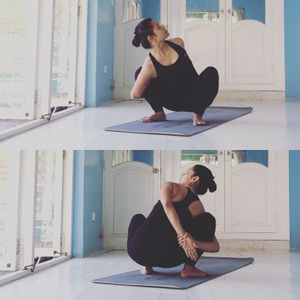Note: This is a project under development. The articles on this wiki are just being initiated and broadly incomplete. You can Help creating new pages.
Difference between revisions of "Ardha Baddha Parivrtta Malasana"
| Line 3: | Line 3: | ||
'''Ardha Baddha Parivrtta Malasana'''<ref name="Ardha Baddha Parivrtta Malasana"/> is an Asana. It is translated as Half Bound Revolved Garland Pose from Sanskrit. | '''Ardha Baddha Parivrtta Malasana'''<ref name="Ardha Baddha Parivrtta Malasana"/> is an Asana. It is translated as Half Bound Revolved Garland Pose from Sanskrit. | ||
| − | + | ==Technique== | |
| + | # Start by doing squatting. During this, put your feet near to each other, with your heels on the ground or supported on the floor. | ||
| + | # Now stretch out your thighs, putting them smoothly wider than your torso. | ||
| + | # Breathe out and bend forward in a way that your torso fits comfortably in between your thighs. | ||
| + | # Now make Anjali Mudra (Namaste posture) by your palms, by your elbows make some pressure against the inner thighs. By this the front part of your torso is stretched. | ||
| + | # Then press your inner thighs against the side of the middle (torso). At that point, extend your arms, and swing them crosswise over with the end goal that your shins fit into the armpits. Hold your lower legs (Ankles). | ||
| + | # Remain in the pose for 60 seconds. Breathe in and release the pose.<ref name="Technique"/> | ||
| + | ==Technique in pictures/animation== | ||
| − | |||
| − | * | + | ==Effects== |
| + | * Stretches and strengthens the shoulders, neck and lower back. | ||
| − | * | + | * Stretches the hips and groins. |
| − | == References == | + | * Improves metabolic rate. |
| + | |||
| + | * Strengthens the feet, ankles, calves and knees. | ||
| + | |||
| + | * Tones the abdomen.<ref name="Effects"/> | ||
| + | |||
| + | ==Related Asanas== | ||
| + | * [[Adho Mukha Svanasana]] | ||
| + | |||
| + | ==Special requisites== | ||
| + | |||
| + | ==Initial practice notes== | ||
| + | Before you begin this practice, sit in a comfortable cross-legged position for 5 to 10 minutes. Place your attention on your natural breath to create a home base for your mind. Whenever your attention strays, bring it back to the breath.<ref name="Initial practice notes"/> | ||
| + | |||
| + | ==References== | ||
<references> | <references> | ||
| − | <ref name=" | + | <ref name="Technique">[https://www.sarvyoga.com/malasana-garland-yoga-pose-steps-and-benefits/ "Methodology of Anantasana"]</ref> |
| + | |||
| + | <ref name="Initial practice notes">[https://www.yogajournal.com/practice/a-beautiful-bind "Beginers tips"]</ref> | ||
| + | |||
| + | <ref name="Effects">[https://365dayspact.wordpress.com/2017/11/29/ardha-baddha-parivrtta-malasana-half-bound-wide-squat-pose-variation-get-the-weight-off-your-shoulders/ "Benefits of Anantasana"]</ref> | ||
| + | |||
</references> | </references> | ||
| + | |||
| + | ==External Links== | ||
| + | * [https://ipfs.io/ipfs/QmXoypizjW3WknFiJnKLwHCnL72vedxjQkDDP1mXWo6uco/wiki/Ardha_Baddha_Parivrtta_Malasana.html Ardha Baddha Parivrtta Malasana on ipfs.net] | ||
| + | * [https://www.tummee.com/yoga-poses/ardha-baddha-padma-paschimottanasana-variation-parivrtta Ardha Baddha Parivrtta Malasana on tummee.com] | ||
[[Category:Yoga]] | [[Category:Yoga]] | ||
Revision as of 18:46, 18 June 2018
Ardha Baddha Parivrtta Malasana[1] is an Asana. It is translated as Half Bound Revolved Garland Pose from Sanskrit.
Contents
Technique
- Start by doing squatting. During this, put your feet near to each other, with your heels on the ground or supported on the floor.
- Now stretch out your thighs, putting them smoothly wider than your torso.
- Breathe out and bend forward in a way that your torso fits comfortably in between your thighs.
- Now make Anjali Mudra (Namaste posture) by your palms, by your elbows make some pressure against the inner thighs. By this the front part of your torso is stretched.
- Then press your inner thighs against the side of the middle (torso). At that point, extend your arms, and swing them crosswise over with the end goal that your shins fit into the armpits. Hold your lower legs (Ankles).
- Remain in the pose for 60 seconds. Breathe in and release the pose.[2]
Technique in pictures/animation
Effects
- Stretches and strengthens the shoulders, neck and lower back.
- Stretches the hips and groins.
- Improves metabolic rate.
- Strengthens the feet, ankles, calves and knees.
- Tones the abdomen.[3]
Related Asanas
Special requisites
Initial practice notes
Before you begin this practice, sit in a comfortable cross-legged position for 5 to 10 minutes. Place your attention on your natural breath to create a home base for your mind. Whenever your attention strays, bring it back to the breath.[4]
References
- ↑ Cite error: Invalid
<ref>tag; no text was provided for refs namedArdha Baddha Parivrtta Malasana - ↑ "Methodology of Anantasana"
- ↑ "Benefits of Anantasana"
- ↑ "Beginers tips"
